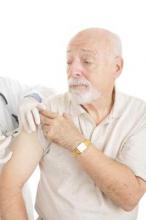The 13-valent polysaccharide conjugate vaccine showed “significant efficacy” against vaccine-type strains of community-acquired pneumonia and vaccine-type invasive pneumococcal disease among the elderly in a large clinical trial in the Netherlands, according to a report published online March 19 in the New England Journal of Medicine.
The PCV13 vaccine’s efficacy in adults aged 65 years and older has never been determined until now. It became possible to assess efficacy in this age group when a serotype-specific urinary antigen detection assay was developed, which can identify Streptococcus pneumonia polysaccharides in the urine of patients suspected of having pneumonia rather than requiring isolation of the organism in culture, said Dr. Marc J. M. Bonten of Julius Center for Health Sciences and Primary Care, University Medical Center Utrecht (the Netherlands), and his associates.
They used the assay to assess PCV13 efficacy in 84,496 older adults who were randomly assigned to receive active vaccine (42,240 participants) or placebo (42,256) and followed for a mean of 4 years in the trial, which was sponsored by Pfizer. In the per-protocol analysis, vaccine efficacy was 46% for preventing a first episode of vaccine-type community-acquired pneumonia, 45% for preventing nonbacteremic and noninvasive vaccine-type community-acquired pneumonia, and 75% for preventing vaccine-type invasive pneumococcal disease.
Evidence of the vaccine’s efficacy became apparent shortly after vaccination occurred and persisted throughout the duration of the study. There was no evidence of any safety concerns in the patients who received the active vaccine, wrote Dr. Bonten and his associates (N. Engl. J. Med. 2015 March 19 [doi:10.1056/NEJMoa1408544]).
The PCV13 vaccine did not show efficacy in preventing death from any cause, but the number of deaths associated with pneumococcal disease in this study was too small to allow a meaningful analysis of this outcome, the investigators noted.


